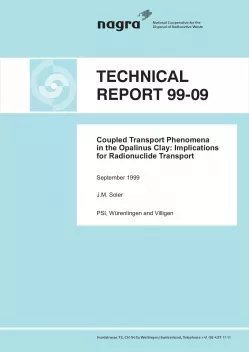
Technical Report NTB 99-09
Coupled Transport Phenomena in the Opalinus Clay: Implications for Radionuclide Transport
Coupled phenomena (thermal and chemical osmosis, hyperfiltration, coupled diffusion, thermal diffusion, thermal filtration, Dufour effect) may play an important role in fluid, solute and heat transport in clay-rich formations, such as the Opalinus Clay (OPA), which are being considered as potential hosts for radioactive waste repositories. In this study, the potential effects of coupled phenomena on radionuclide transport in the vicinity of a repository for vitrified high-level radioactive waste (HLW) and spent nuclear fuel (SF) hosted by the Opalinus Clay, at times equal to or greater than the expected lifetime of the waste canisters (about 1000 years), have been addressed.
Firstly, estimates of the solute fluxes associated with chemical osmosis, hyperfiltration, thermal diffusion and thermal osmosis have been calculated. Available experimental data concerning coupled transport phenomena in compacted clays, and the hydrogeological and geochemical conditions to which the Opalinus Clay is subject, have been used for these estimates. These estimates suggest that thermal osmosis is the only coupled transport mechanism that could have a strong impact on solute and fluid transport in the vicinity of the repository.
Secondly, estimates of the heat fluxes associated with thermal filtration and the Dufour effect in the vicinity of the repository have been calculated. The calculated heat fluxes are absolutely negligible compared to the heat flux caused by thermal conduction.
As a further step to obtain additional insight into the effects of coupled phenomena on solute transport, the solute fluxes associated with advection, chemical diffusion, thermal and chemical osmosis, hyperfiltration and thermal diffusion have been incorporated into a simple one-dimensional transport equation. The analytical solution of this equation, with appropriate parameters, shows again that thermal osmosis is the only coupled transport mechanism that could have a strong effect on repository performance, in agreement with the previous estimates.
Finally, the results of two- and three-dimensional simple flow models incorporating advection (Darcy’s law) and thermal osmosis show that, under the conditions in the vicinity of the repository at the time scales of interest, the advective component of flow will oppose and cancel the thermal-osmotic component.
After evaluating the different coupled transport mechanisms, the conclusion is that coupled phenomena will only have a very minor impact on radionuclide transport in the Opalinus Clay, at least under the conditions at times equal to or greater than the expected lifetime of the waste canisters (about 1000 years).
